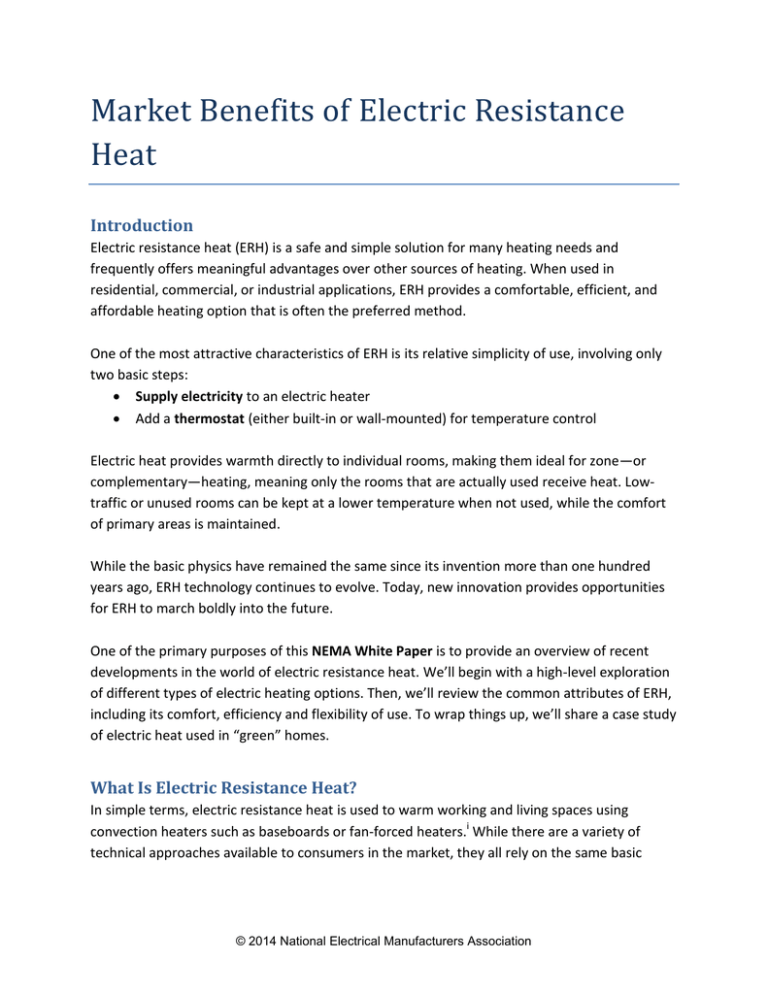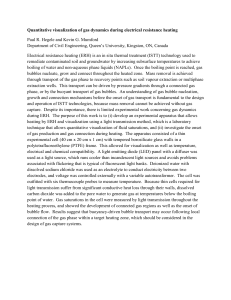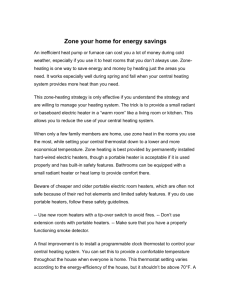Market Benefits of Electric Resistance Heat
advertisement

Market Benefits of Electric Resistance Heat Introduction Electric resistance heat (ERH) is a safe and simple solution for many heating needs and frequently offers meaningful advantages over other sources of heating. When used in residential, commercial, or industrial applications, ERH provides a comfortable, efficient, and affordable heating option that is often the preferred method. One of the most attractive characteristics of ERH is its relative simplicity of use, involving only two basic steps: Supply electricity to an electric heater Add a thermostat (either built-in or wall-mounted) for temperature control Electric heat provides warmth directly to individual rooms, making them ideal for zone—or complementary—heating, meaning only the rooms that are actually used receive heat. Lowtraffic or unused rooms can be kept at a lower temperature when not used, while the comfort of primary areas is maintained. While the basic physics have remained the same since its invention more than one hundred years ago, ERH technology continues to evolve. Today, new innovation provides opportunities for ERH to march boldly into the future. One of the primary purposes of this NEMA White Paper is to provide an overview of recent developments in the world of electric resistance heat. We’ll begin with a high-level exploration of different types of electric heating options. Then, we’ll review the common attributes of ERH, including its comfort, efficiency and flexibility of use. To wrap things up, we’ll share a case study of electric heat used in “green” homes. What Is Electric Resistance Heat? In simple terms, electric resistance heat is used to warm working and living spaces using convection heaters such as baseboards or fan-forced heaters.i While there are a variety of technical approaches available to consumers in the market, they all rely on the same basic © 2014 National Electrical Manufacturers Association physical property: passing an electrical current through a resistor converts electrical energy into heat.ii All ERH products rely on this same fundamental physical concept. A Lesson on Heat Transfer From a physics perspective, heat may be transferred by three different methods: conduction, convection, and radiation. Let’s review each: Thermal Conduction Heat is transferred via conduction when a cooler object comes into physical contact with a warmer object. A typical example of heat transfer by way of conduction is a pot of cold water growing warmer as it sits on a hot electric stove. Thermal Convection Natural convection occurs when an object is heated to a temperature warmer than the air surrounding it. As the air near the object warms, it rises, and cooler air takes its place to continue the heating process. Electric baseboard heaters use this natural convection to transfer heat from warm resistive elements into room air. Fan-forced heaters use forced convection to accelerate the process by artificially circulating warm air, but the technology is still based on the naturally occurring principle. Thermal Radiation Radiation is a process by which energy, in the form of electromagnetic waves (visible light, infrared, etc.), travels from a heated surface directly and rapidly to objects in the path of those waves. Unlike conductive and convective heating systems, radiant heating systems do not heat air but, instead, heat objects, similar to how we feel the sun’s heat. Ceramic and quartz radiant panels are examples of this method. Although floor cables and ceiling panels are often described as ‘radiant,’ they actually combine conduction (through direct contact with feet), convection (by heating the air), and radiation. Popular Residential and Commercial Heating Products Electric Baseboard Electric Baseboards are the most common electric heaters and use the convection method to quietly circulate warm air in a room. As the heating elements get warm, air naturally rises, pulling cooler air behind it across the warm elements. Baseboard heaters are often installed below a window, as in the picture below, to counteract the effect of cold air coming into the room. © 2014 National Electrical Manufacturers Association Figure 1 - Electric baseboard unit under widow Typically, homes (or offices) using electric baseboard heaters are controlled by unique thermostats, sometimes as many as one in each room or space. This provides people with a great degree of flexibility and operational efficiency, allowing them to heat only those rooms they occupy, and thereby saving both energy and money. © 2014 National Electrical Manufacturers Association Fan-Forced / Ducted Figure 2 - Electric resistance wall heater Fan heaters include an electric fan to quickly transfer energy from the electric heating element to the room. Fan heaters in a bathroom or bedroom allow for quick warm-up of a room when the overall home temperature may be kept at lower levels, guaranteeing comfort where and when consumers need it while maintaining efficiency. Many wall heaters, such as the one shown above, have a built-in thermostat for greater ease of use and stability of room temperature. In addition to fan heaters, ERH can be packaged into a blower cabinet and installed with ductwork to provide heat to larger areas—for instance, an entire house. Sometimes this application is paired with an electric heat pump or air conditioner to supply both heating and cooling to the space. An even greater level of efficiency can be achieved if a fan-forced electric heater or thermal storage heater is interfaced with an electric heat pump. A heat pump typically draws energy from outside air and uses it to heat or cool the room. When paired with an electric heater, a heat pump can be utilized at much lower outdoor temperatures, thereby increasing efficiency and reducing the total energy required for heating, all while ensuring the greatest comfort for the consumer. Radiant Heat Radiant electric resistance heat comes in several varieties, including quartz and ceramic element heaters—which are often used in three-season rooms and outdoors—as well as floor cables and ceiling panels which can be used throughout the home. Quartz and Figure 3 - Radiant ceiling panel in home office © 2014 National Electrical Manufacturers Association ceramic heaters directly heat objects, so even when the ambient air temperature is low, people who are within range still feel comfortable. Radiant floor cables combine conductive energy, through direct contact with the occupants’ feet, with radiant heating and convective airflow. Ceiling panels provide a similar combination of radiant and convective heating, but without the conductive heat from direct contact as with radiant flooring. Energy efficiency is achieved because overall ambient air temperatures can be kept lower while still maintaining comfort Electric Thermal Storage Some utilities offer discounts when the demand for electricity is relatively low and, conversely, charge more when the demand for electricity is relatively high. “Electric Thermal Storage Systems (ETS)” take advantage of these rate structures by heating a storage medium, often water or bricks, during low-cost times and releasing the stored heat on-demand when the rates peak. This avoids the consumption of electricity when it is more expensive. More recently, a new variety of ETS application has appeared called “grid-interactive electric thermal storage” Figure 4 - view of a typical thermal energy or GETS. This product performs like traditional ETS storage room unit products except that it is capable of two-way communication with the local utility. Earlier generation ETS products were only capable of oneway communication from the utility to the appliance. Two-way communication affords a whole new level of control for the utility and opens the door for additional services and efficiencies, such as electric grid load balancing and the storage of excess renewable energy when supply exceeds demand. Energy storage is increasingly important to allow the integration of more renewable generation. ETS Space and Water Heaters have proven to have a long, maintenancefree life—typically 25 years—and are relatively inexpensive. Markets and Applications Electric heat is commonly used in residential, commercial, and industrial applications.iii In any situation, ERH may be the primary heating system or may be used to supplement another system. ERH is often used in commercial applications to offset the size of forced-air furnaces. This allows for a smaller capacity unit to be used, with electric heating providing supplemental heat on only the coldest days of the year or in the coolest areas of the building. Additionally, © 2014 National Electrical Manufacturers Association multi-family housing builders are increasingly turning to electric heat to efficiently allow their tenants to control their comfort level. Figure 5 - example of ERH wall heater supplementing main heating system Why Is Electric Resistance Heat So Popular? Over the years, electric resistance heat has remained a popular choice in the market for residential and commercial space heating for a variety of reasons that we’ll explore here. ERH Is Affordable One of the most important benefits of electric heat is affordability. The initial purchase, installation, maintenance, and operating costs are typically much less than other heating options. In regards to initial costs, electric baseboard heaters are the least expensive method to warm cold rooms, which may explain their popularity. Electric heat is highly efficient because it’s typically used to heat just the rooms or spaces actually occupied. Only ERH offers affordability across all these areas. New products, such as micro-zone wireless controls, are taking these benefits even further by allowing multiple heaters to operate independently, even when on a shared circuit. iv ERH Is Efficient Simply stated, electric resistance heaters, whether baseboard, fan-forced, electric thermal storage, radiant, or other form, are nearly 100% efficient at converting electricity into useable heat. ERH can also be used with electronic thermostats that combine a high degree of comfort control (maintains temperature within 0.5°C/0.9°F) with the ability to deliver a proportion of the total wattage of the heater. This means that electric heaters can operate continuously at a © 2014 National Electrical Manufacturers Association lower level, which is more efficient and comfortable than the peaks and valleys experienced with the full-on or full-off mode of most heating systems. Electronic thermostats have the potential to save customers up to 10% when compared with traditional mechanical thermostat control when coupled with electric resistance heaters. ERH Is Comfortable (and Controllable) While comfort is clearly subjective, few will contest that heating the space you are in to the temperature you want is most comforting. ERH does this especially well and without uneven hot/cold blasts of air. Homes and offices heated with ERH have the luxury of individual space control with separate thermostats available for every room. Moreover, ERH doesn’t suffer from the drafty temperature swings often associated with other types of heating systems that start and end with blowing cool air. ERH provides consistent, warm, even temperature control for maximum comfort. ERH Is Clean Anyone who has lived in a home with oil heat is familiar with the smell associated with the combustion of oil in a furnace. With ERH, there are no bi-products of combustion and no unpleasant aromas. ERH Is Quiet The fact that ERH is virtually silent is one of the features most valued by customers. Even when fan-forced wall heaters are used, the background noise is only a fraction of the air noise generated by central ducted systems such as oil or gas furnaces. ERH Is Scalable Many homeowners find it easy to add a bonus room to their home, or turn the basement into a living area using electric heat to warm these new areas. Even homes with central heating have rooms above cold spaces such as a garage, and areas that are a long distance from the furnace and basements in general that are often cold and require supplemental heating. ERH’s scalability makes it ideal to solve these challenges and allows homeowners to continually add additional sources of heat, unlike central heating systems which can be expensive to modify. ERH Is Safe When properly installed and operated, electric heat is a very safe way to add complementary heat to homes and offices. There is no combustion, as in gas and oil furnaces, and no poisonous combustion gases to exhaust out of the house. © 2014 National Electrical Manufacturers Association ERH Is Green: The Future of Low Carbon Heating From an environmental perspective, ERH offers consumers an affordable “green” choice. Electric generation in the U.S. is moving towards lower carbon sources—including the increased use of no-carbon options like renewables, hydro, and nuclear energy (together almost 40% of U.S. generation). ERH is fully compatible with the use of electricity derived from renewable sources like wind and solar energy. One of the most exciting developments in the world of electric resistance heating is its integration with the growing deployment of grid-scale renewable energy by electric utilities. Only electric heating is compatible with electricity generated using wind or solar. Gas appliances are simply incompatible.v With many utilities offering consumers the opportunity to purchase electricity generated from renewable energy, homes heated with ERH can proudly boast of being green. A relatively new development for ERH is “grid-interactive electric thermal storage,” or GETS (see earlier discussion.) This new product is designed to assist utilities in storing excess renewable energy on their systems by charging a storage medium within space heaters and water heaters. This stored energy can then be used later on demand. This allows electrical utilities to maximize the use of renewable energy that would have otherwise been wasted. It also helps them reduce their carbon emissions, sometimes by more than 50%. ERH Has Low Maintenance ERH has very few—often no—moving parts, which translates directly into lower maintenance costs and greater reliability. A simple cleaning once or twice a year is typically sufficient to keep an electric heater running smoothly. Passivhaus Case Studies Most countries are experiencing a “green revolution” where consumers and builders are more sensitive to environmental issues. An excellent case study in the building community is Passivhaus, meaning “passive house” in German. The Passivhaus approach to building is to superinsulate structures to the point that only a minimal amount of heating is required. And overwhelmingly, Passivhaus builders continually choose to use ERH for their heating needs, because it can be derived completely from clean, Figure 6 - Passivhaus © 2014 National Electrical Manufacturers Association renewable sources. In one instance, the builder of a Passive House stated, “Whitmore’s house has no furnace—a significant up front cost savings. On the coldest days it can be heated with two small baseboard electric heaters.”vi In another, because the Passive House’s energy demand for space heating was reduced by 90%, “the resulting heat required to keep the building at 70 degrees is very low (2,000 watts at peak demand), which allows a Passive House’s traditional heating system to be drastically simplified to a few feet of electric baseboard controlled by a thermostat in each room. The cost to install this simplified heating system is about $500—replacing the standard heating system consisting of a boiler, radiant slab, pumps, fuel tanks, chimney and manifolds—saving around $15,000.”vii Electric resistance heat and green construction clearly go hand-in-hand. Conclusion Electric resistance heat continues to be a popular choice with consumers and commercial users for good reason. It is affordable, efficient, clean, and comfortable, to name just a few of its many qualities. Moreover, ERH is uniquely situated to assist in the deployment of greater amounts of electricity generated from renewable energy sources like wind and solar power. As with the electric car, consumer consciousness surrounding the use of clean electricity is growing exponentially, and it is reasonable to think that favorable attitudes toward electric heating will grow accordingly. It’s easy to see why the future of electric resistance heating is so bright— because it provides small- and large-scale solutions for many of the world’s energy challenges. © 2014 National Electrical Manufacturers Association Appendix This white paper was developed by the NEMA Electric Resistance Heating Section of the National Electrical Manufacturers Association. Section approval of the white paper does not necessarily imply that all section members voted for its approval or participated in its development. At the time it was approved, the Electric Resistance Heating Section was composed of the following members: Cadet Manufacturing Company Vancouver, WA Dimplex North America Ltd. Cambridge (ON), Canada Emerson Rosemont, IL Marley Engineered Products Bennettsville, SC Steffes Corporation Dickinson, ND Stelpro Design Inc. St. Bruno-de-Montarville (QC), Canada TPI Corporation Johnson City, TN i ERH is also used in a number of applications other than space heating, including activities like ovens for drying painted products (car parts for instance) and the environmental remediation of hazardous waste sites. This paper, however, will focus only on the residential and commercial space heating aspects of ERH. ii http://en.wikipedia.org/wiki/Electric_heating#Environmental_and_efficiency_aspects iii ERH is also used extensively in industrial applications but, as noted above, this NEMA White Paper is focused on residential and commercial space heating applications. iv Insert cite v Another significant difference is that most fossil fuels, such as propane, fuel oil, wood, coal and other biomass, require the prior purchase, storage and payment of these heating fuels. Electricity is available on an “as needed basis” and consumers generally pay for it several weeks after using it. vi http://citytank.org/2011/05/05/passivhaus-is-german-for-no-brainer/. vii http://www.gologic.us/passivhaus/cost-benefit-of-a-passive-house/. © 2014 National Electrical Manufacturers Association

